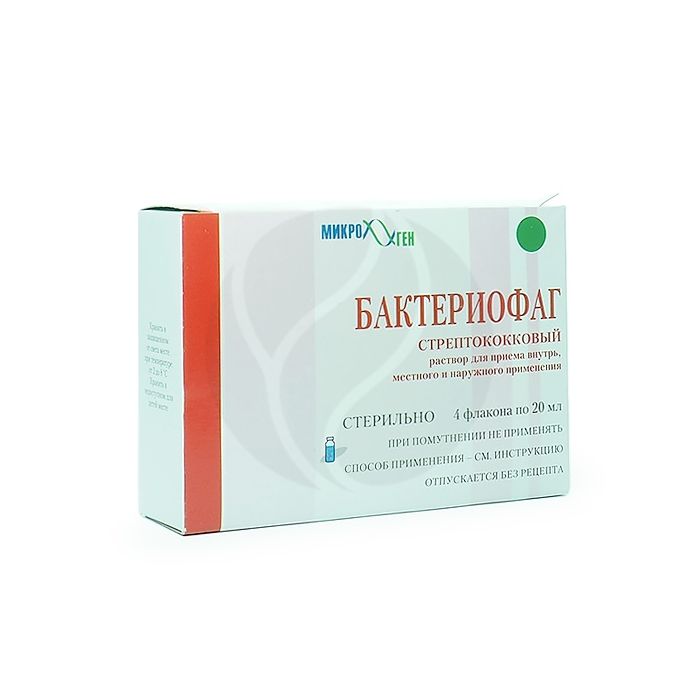Bacteriophage streptococcal solution 20ml, No. 4
Expiration Date: 05/2027
Russian Pharmacy name:
Бактериофаг стрептококковый раствор 20мл, №4
Treatment and prevention of diseases caused by Streptococcus bacteria as part of complex therapy:
diseases of the ear, throat, nose, respiratory tract and lungs (inflammation of the sinuses, middle ear, tonsillitis, pharyngitis, laryngitis, tracheitis, bronchitis, pneumonia, pleurisy);
surgical infections (suppuration of wounds, burns, abscess, phlegmon, boils, carbuncles, hydradenitis, panaritium, paraproctitis, mastitis, bursitis, osteomyelitis);
urogenital infections (urethritis, cystitis, pyelonephritis, colpitis, endometritis, salpingo-oophoritis);
enteric infections (gastroenterocolitis, cholecystitis), intestinal dysbiosis;
generalized septic diseases;
purulent-inflammatory diseases of newborns (omphalitis, pyoderma, conjunctivitis, gastroenterocolitis, sepsis, etc.);
other diseases caused by streptococci.
For prophylactic purposes, the drug is used for the treatment of postoperative and freshly infected wounds, as well as for the prevention of nosocomial infections for epidemic indications.
An important condition for effective phage therapy is a preliminary determination of the phage sensitivity of the pathogen.
The drug is used for oral administration (through the mouth), rectal administration, applications, irrigation, introduction into the cavity of wounds, vagina, uterus, nose, sinuses and drained cavities.
Treatment of pyoinflammatory diseases with localized lesions should be carried out simultaneously both locally and by taking the drug orally for 7-20 days (according to clinical indications).
If, before using the bacteriophage, chemical and antiseptics were used to treat wounds, the wound should be thoroughly washed with a sterile 0.9% sodium chloride solution.
Depending on the focus of infection, the bacteriophage is used:
1. In the form of irrigation, lotions and tamponing in a volume of up to 200 ml, depending on the size of the affected area. In case of abscess after removal of purulent contents by puncture, the drug is administered in an amount less than the volume of removed pus. In osteomyelitis, after appropriate surgical treatment, a bacteriophage is poured into the wound, 10-20 ml each.
2. When injected into cavities (pleural, articular and other limited cavities) up to 100 ml, a capillary drainage is left, through which the bacteriophage is injected for several days.
3. For cystitis, pyelonephritis, urethritis, the drug is taken orally. If the cavity of the bladder or renal pelvis is drained, the bacteriophage is injected through the cystostomy or nephrostomy 1-2 times a day, 20-50 ml into the bladder and 5-7 ml into the renal pelvis;
4. In case of purulent-inflammatory gynecological diseases, the drug is injected into the cavity of the vagina, uterus in a dose of 5-10 ml once daily,
5. For colpitis - 10 ml by irrigation or tamponing 2 times a day. Tampons are laid for 2 hours.
6. For purulent-inflammatory diseases of the ear, throat, nose, the drug is administered in a dose of 2-10 ml 1-3 times a day. The bacteriophage is used for rinsing, washing, instilling, introducing moistened turundas (leaving them for 1 hour).
7. In case of enteral infections, intestinal dysbiosis, the drug is taken orally 3 times a day 1 hour before meals for 7-20 days according to clinical indications.
It is possible to combine a double oral administration with a single rectal administration of a single age-specific dose of bacteriophage in the form of an enema after bowel movement.
The use of a bacteriophage in children (up to 6 months).
For sepsis, enterocolitis of newborns, including premature babies, bacteriophage is used in the form of high enemas (through a gas outlet tube or catheter) 2-3 times a day at a dose of 5-10 ml.
In the absence of vomiting and regurgitation, the drug may be administered by mouth. In this case, it is mixed with breast milk. A combination of rectal (in the form of high enemas) and oral (through the mouth) administration of the drug is possible. The course of treatment is 5-15 days.
With a recurrent course of the disease, repeated courses of treatment are possible.
In order to prevent sepsis and enterocolitis in intrauterine infection or the risk of nosocomial infection in newborns, bacteriophage is used in the form of enemas 2 times a day for 5-7 days.
In the treatment of omphalitis, pyoderma, - infected wounds, the drug is used in the form of applications twice daily (a gauze napkin is moistened with a bacteriophage and applied to the umbilical wound or the affected area of ??the skin). Precautions for use.
ѕеред использованием флакон с бактериофагом необходимо взболтать и просмотреть. ѕрепарат должен быть прозрачным и не содержать осадка. ¬нимание! ѕри помутнении препарат не примен¤ть! ¬следствие содержани¤ в препарате питательной среды, в которой могут развиватьс¤ бактерии из окружающей среды, вызыва¤ помутнение препарата, необходимо при вскрытии флакона соблюдать следующие правила: тщательно мыть руки; обработать колпачок спиртсодержащим раствором; сн¤ть колпачок, не открыва¤ пробки; не класть пробку внутренней поверхностью на стол или другие предметы; не оставл¤ть флакон открытым; вскрытый флакон хранить только в холодильнике. ¬скрытие флакона и извлечение необходимого объема препарата может проводитьс¤ стерильным шприцем путем прокола пробки. ѕрепарат из вскрытого флакона при соблюдении условий хранени¤, вышеперечисленных правил и отсутствии помутнени¤ может быть использован в течение всего срока годности.
Solution for oral administration, local and external use, yellow, transparent.
streptococcal bacteriophage *
* sterile phagolysate of Streptococcus strains
Excipients: 8-hydroxyquinoline sulfate monohydrate - 0.0001 g / ml.
hypersensitivity to the components of the drug.
Clinical and pharmacological group:
Immunobiological preparation - bacteriophage
pharmachologic effect
The drug has the ability to specifically lyse Streptococcus bacteria.
Side effect
Not installed.
Application during pregnancy and lactation
The use of this medication during pregnancy and lactation is possible in the presence of infections caused by phage-sensitive strains of streptococci (as recommended by a doctor).
Application in children
Applied according to indications in accordance with the dosage regimen.
special instructions
Influence on the ability to drive vehicles and use mechanisms No data available.
Overdose
Not installed.
Drug interactions
The use of a bacteriophage does not exclude the use of other antibacterial drugs.

